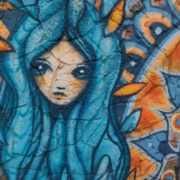Can practicing self-compassion reduce shame?
I describe shame as that toxic, black mold that grows in dark, damp places that can make you sick when you don’t even know it is there. In order to get healthy, first we must become aware of the mold’s existence and then we need to invite air and light into the space, because mold can’t survive in the light. It is the same with shame. Shame on the surface functions as an internal regulator to discourage us from violating moral and social norms. However, when small seeds of shame are planted, especially when we are children, it grows just like toxic mold, creating a very unhealthy internal state of being. From these toxic seeds of shame grow weeds, such as feelings of ‘less than’ and thoughts of ‘not being good enough’. What if there was a simple internal cleaning solution that could eliminate that toxic shame? Well, research on self-compassion is becoming the light that is needed to kill off those weeds at their very roots!
When I was little I had a lot of things happening to me that brought shame, including my parents getting divorced and being poor due to being raised by a single mother. With no money to spare, we found ourselves pulling things out of the Good Will bins, instead of putting things into them, so often our clothes did not fit right (I remember high-water pants before they were a fashion item). In such a vulnerable place, my mom was taken advantage of by men and I witnessed domestic violence. These types of circumstances were out of my control, but that didn’t stop the seeds of mold from taking hold and sprouting nasty weeks. And those weeds, always present, drove my behaviors for many years.
Finally, when my body began to show signs of disease, I realized I needed to change something. With the help of a good therapist, I was able to gain insight into how traumatizing those events were to a child and how the shame guided my behavioral responses, such as trying to be perfect all of the time and taking responsibility for ‘out-of-scope’ tasks and events. Add my people-pleasing part and I had the trifecta for anxiety, exhaustion, depression and many other symptoms of trauma.
When I was able to offer myself the same compassion I would offer others that were experiencing some sort of suffering, I began to feel a sense of relief. My thoughts changed from ‘What is wrong with you’ to ‘What happened to you’. And I was finally able to move into a space of understanding, opening the door to choice when it came to how I wanted to act in this world. Offering myself compassion by shining light on the toxic mold of shame opened the door to true peace of mind. Cultivating compassion has been shown to reduce the negative chemicals (e.g., cortisol, etc.) and increase the positive ones (e.g., oxytocin, etc.) in the brain. And with this data, new models of therapy are emerging within the field of trauma-informed care. One of the most recent and promising ones, Somatic Self-Compassion® training is a trauma-informed self-compassion training that was designed to combine interoception (how we feel on the inside) and sensory modulation (adaptive responses to external changes) in order to teach individuals more effective coping with current and past stress.
One of the most recent feasibility research studies utilizing Somatic Self-Compassion® included shame as a variable to better understand how stress, shame and self-compassion might be related. What this study showed was that combining trauma-informed care with the increased focus on somatic/body intelligence (i.e., interoception and sensory modulation) reduces shame, including body shame and that such training would be a good fit for trauma survivors.
To read the full study, click on the link below:



